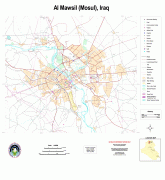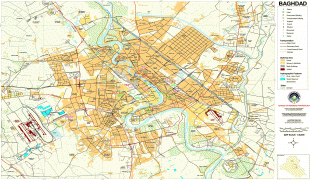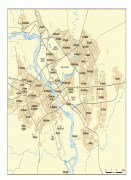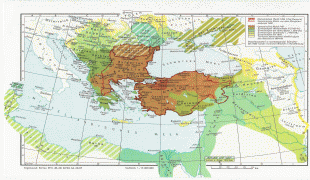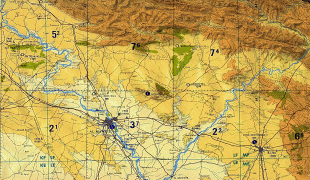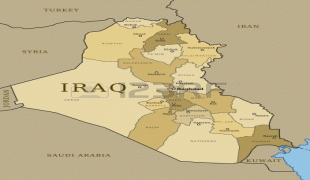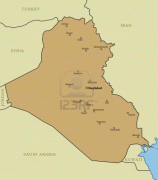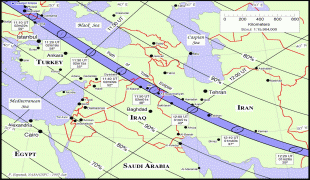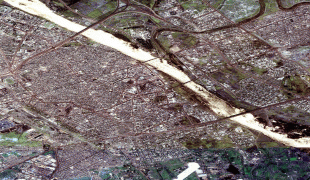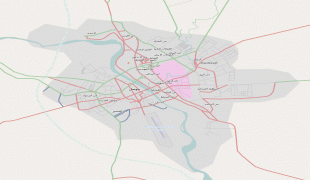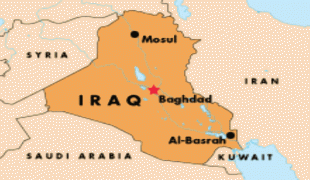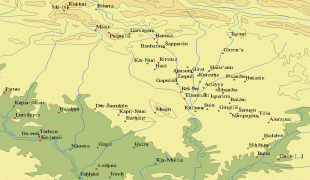Mosul
Mosul (الموصل, مووسڵ, Turkish: Musul, ) is a major city in northern Iraq, serving as the capital of Nineveh Governorate. The city is considered the second largest city in Iraq in terms of population and area after the capital Baghdad, with a population of over 3.7 million. Mosul is approximately 400 km north of Baghdad on the Tigris river. The Mosul metropolitan area has grown from the old city on the western side to encompass substantial areas on both the "Left Bank" (east side) and the "Right Bank" (west side), as locals call the two riverbanks. Mosul encloses the ruins of the ancient Assyrian city of Nineveh on its east side.
Mosul and its surroundings have an ethnically and religiously diverse population; a large majority of its population are Arabs, with Assyrians, Turkmens, and Kurds, and other, smaller ethnic minorities comprising the rest of the city's population. Sunni Islam is the largest religion, but there are a significant number of Christians, as well as adherents of other sects of Islam and various other minority religions.
Mosul is considered to be among the larger and more historically and culturally significant cities of the Arab world. Due to Mosul's strategic location it has traditionally served as a hub of international commerce and travel. The North Mesopotamian dialect of Arabic, commonly known as Moslawi, is named after the city of Mosul and is widely spoken in the region.
Historically, important products of the area include Mosul marble and oil. Mosul is home to the University of Mosul and its renowned Medical College, one of the largest educational and research centers in the Middle East.
Together with the nearby Nineveh Plains, Mosul is one of the historic centers of the Assyrian people.
The city's name is first mentioned by Xenophon in his expeditionary logs in Achaemenid Assyria of 401 BC, during the reign of the Persian Achaemenid Empire. There, he notes a small Assyrian town of "Mépsila" (Μέψιλα) on the Tigris around where Mosul is today (Anabasis, III.iv.10). It may be safer to identify Xenophon's Mépsila with the site of Iski Mosul, or "Old Mosul", about 30 km north of modern Mosul, where six centuries after Xenophon's report, the Sasanian Empire's center of Budh-Ardhashir was built. In any case, "Mepsila" is doubtless the root of the modern name.
In its current Arabic form and spelling, the term Mosul, or rather "Mawsil", means "linking point"—or, loosely, "Junction City", in Arabic. On Mosul's eastern side are the ruins of the ancient city of Nineveh and Assyrians still call the entire city Nineveh (or Ninweh).
Mosul is also nicknamed al-Faiha ("the Paradise"), al-Khaḍrah ("the Green"), and al-Hadbah ("the Humped"). It is sometimes called "The Pearl of the North" and "the city of a million soldiers".
Mosul and its surroundings have an ethnically and religiously diverse population; a large majority of its population are Arabs, with Assyrians, Turkmens, and Kurds, and other, smaller ethnic minorities comprising the rest of the city's population. Sunni Islam is the largest religion, but there are a significant number of Christians, as well as adherents of other sects of Islam and various other minority religions.
Mosul is considered to be among the larger and more historically and culturally significant cities of the Arab world. Due to Mosul's strategic location it has traditionally served as a hub of international commerce and travel. The North Mesopotamian dialect of Arabic, commonly known as Moslawi, is named after the city of Mosul and is widely spoken in the region.
Historically, important products of the area include Mosul marble and oil. Mosul is home to the University of Mosul and its renowned Medical College, one of the largest educational and research centers in the Middle East.
Together with the nearby Nineveh Plains, Mosul is one of the historic centers of the Assyrian people.
The city's name is first mentioned by Xenophon in his expeditionary logs in Achaemenid Assyria of 401 BC, during the reign of the Persian Achaemenid Empire. There, he notes a small Assyrian town of "Mépsila" (Μέψιλα) on the Tigris around where Mosul is today (Anabasis, III.iv.10). It may be safer to identify Xenophon's Mépsila with the site of Iski Mosul, or "Old Mosul", about 30 km north of modern Mosul, where six centuries after Xenophon's report, the Sasanian Empire's center of Budh-Ardhashir was built. In any case, "Mepsila" is doubtless the root of the modern name.
In its current Arabic form and spelling, the term Mosul, or rather "Mawsil", means "linking point"—or, loosely, "Junction City", in Arabic. On Mosul's eastern side are the ruins of the ancient city of Nineveh and Assyrians still call the entire city Nineveh (or Ninweh).
Mosul is also nicknamed al-Faiha ("the Paradise"), al-Khaḍrah ("the Green"), and al-Hadbah ("the Humped"). It is sometimes called "The Pearl of the North" and "the city of a million soldiers".
Map - Mosul
Map
Country - Mesopotamia
 |
|
| Flag of Iraq | |
The Sumerians and Akkadians (including Assyrians and Babylonians) originating from different areas in present-day Iraq, dominated Mesopotamia from the beginning of written history (c. 3100 BC) to the fall of Babylon in 539 BC, when it was conquered by the Achaemenid Empire. It fell to Alexander the Great in 332 BC, and after his death, it became part of the Greek Seleucid Empire. Later the Arameans dominated major parts of Mesopotamia (c. 900 BC – 270 AD).
Currency / Language
| ISO | Currency | Symbol | Significant figures |
|---|---|---|---|
| IQD | Iraqi dinar | عد | 3 |
| ISO | Language |
|---|---|
| AR | Arabic language |
| HY | Armenian language |
| KU | Kurdish language |






